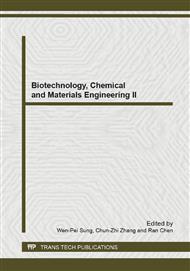[1]
R. Grantham, C. Gautier, M. Gouy, R. Mercier, and A. Pave, Codon catalog usage and the genome hypothesis, Nucleic Acids Res. 8 (1980) 197.
DOI: 10.1093/nar/8.1.197-c
Google Scholar
[2]
P.M. Sharp, M. Averof, A.T. Lloyd, G. Matassi, and J.F. Peden, DNA sequence evolution: the sounds of silence, Philos Trans R Soc Lond B Biol Sci. 349 (1995) 241–247.
Google Scholar
[3]
L. Duret, Evolution of synonymous codon usage in metazoans, Curr Opin Genet Dev. 12 (2002) 640–649.
DOI: 10.1016/s0959-437x(02)00353-2
Google Scholar
[4]
J. Ma, A. Campbell, and S. Karlin, Correlations between shine-dalgarno sequences and gene features such as predicted expression levels and operon structures, Journal of Bacteriology. 184 (2002) 5733–5745.
DOI: 10.1128/jb.184.20.5733-5745.2002
Google Scholar
[5]
A. E. Walker, Synonymous codon bias is related to gene length in Escherichia coli: selection for translational accuracy? , Molecular Biology and Evolution. 13 (1996) 864–872.
DOI: 10.1093/oxfordjournals.molbev.a025646
Google Scholar
[6]
M. Nakamura, and M. Sugiura, Translation efficiencies of synonymous codons are not always correlated with codon usage in tobacco chloroplasts, The Plant Journal. 49 (2007) 128–134.
DOI: 10.1111/j.1365-313x.2006.02945.x
Google Scholar
[7]
J.B. Plotkin, J. Dushoff, M.M. Desai, and H.B. Fraser, Codon usage and selection on proteins, Jouranl of Molecular Evolution. 63 (2006) 635–653.
DOI: 10.1007/s00239-005-0233-x
Google Scholar
[8]
S. Noboru, Two aspects of DNA base composition: G+C content and translation-coupled deviation from intra-strand rule of A = T and G = C, Journal of Molecular Evolution. 49 (1999) 49–62.
DOI: 10.1007/pl00006534
Google Scholar
[9]
S. Kanaya, Y. Yamada, Y. Kudo, and T. Ikemura, Studies of codon usage and tRNA genes of 18 unicellular organisms and quantification of Bacillus subtilis tRNAs: gene expression level and speciesspecific diversity of codon usage based on multivariate analysis, Gene. 238 (1999).
DOI: 10.1016/s0378-1119(99)00225-5
Google Scholar
[10]
S. Noguchi, and Y. Satow, Purification of human β2-adrenergic receptor expressed in methylotrophic yeast Pichia pastoris, Journal of Biochemistry. 140 (2006) 799–804.
DOI: 10.1093/jb/mvj211
Google Scholar
[11]
N. Sueoka, and Y. Kawanishi, DNA G+C content of the third codon position and codon usage biases of human genes, Gene. 261 (2000) 53–62.
DOI: 10.1016/s0378-1119(00)00480-7
Google Scholar
[12]
X.F. Wan, D. Xu, A. Kleinhofs, and J.Z. Zhou, Quantitative relationship between synonymous codon usage bias and GC composition across unicellular genomes, BMC Evolutionary Biology. 4 (2004) 19.
Google Scholar
[13]
K. Sau, S.K. Gupta, S. Sau, and T.C. Ghosh, Synonymous codon usage bias in 16 Staphylococcus aureus phages: implication in phage therapy, Virus Research. 113 (2005) 123–231.
DOI: 10.1016/j.virusres.2005.05.001
Google Scholar
[14]
P. Segers, W. Mannheim, M. Vancanneyt, K.D. Brandt, K.H. Hinz, K. Kersters, P. Vandamme, Riemerella anatipestifer gen. nov., comb. nov., the Causative Agent of Septicemia Anserum Exsudativa, and Its Phylogenetic Affiliation within the Flavobacterium-Cytophaga rRNA Homology Group, Int. J. Syst. Bacteriol. 43 (1993).
DOI: 10.1099/00207713-43-4-768
Google Scholar
[15]
T.S. Sandhu. Riemerella anatipestifer Infection, in: Y.M. saif (Eds. ), Diseases of poultry, 12th ed Blackwell Publishing Ltd., Oxford, 2008, pp.758-764.
Google Scholar
[16]
X.J. Wang, D.K. Zhu, M.S. Wang, A.C. Cheng, R.Y. Jia, Y. Zhou, Z.L. Chen, Q. H Luo, F. Liu, Y. Wang X.Y. Chen, Complete genome sequence of Riemerella anatipestifer reference strain, Journal of Bacteriology. 194 (2012) 3270-3271.
DOI: 10.1128/jb.00366-12
Google Scholar
[17]
F. Wright, The effective number of codons used in a gene, Gene. 87 (1990) 23-29.
DOI: 10.1016/0378-1119(90)90491-9
Google Scholar
[18]
P. M. Sharp, and W. H. Li, The codon adaptation index-a measure of directional synonymous codon usage bias, and its potential applications, Nucleic. Acids. Res., 15 (1987) 1281-1295.
DOI: 10.1093/nar/15.3.1281
Google Scholar
[19]
H. Sakai, T. Washio, R. Saito, A. Shinagawa, M. Itoh, K. Shibata, et al, Correlation between sequence conservation of the 5' untranslated region and codon usage bias in Mus musculus genes", Gene. 276 (2001) 101-105.
DOI: 10.1016/s0378-1119(01)00671-0
Google Scholar
[20]
H. Lü, W.M. Zhao, Y. Zheng, H. Wang, M. Qi and X.P. Yu, Analysis of synonymous codon usage bias in Chlamydia, Acta Biochim Biophys Sin. 37 (2005) 1-10.
DOI: 10.1093/abbs/37.1.1
Google Scholar
[21]
J. M. Comeron, and M. Aguade, An evaluation of measures of synonymous codon usage bias, J Mol Evol. 47 (1998) 268-274.
DOI: 10.1007/pl00006384
Google Scholar
[22]
J. A. Novembre, Accounting for background nucleotide composition when measuring codon usage bias, Mol Biol Evol. 19 (2002) 1390-1394.
DOI: 10.1093/oxfordjournals.molbev.a004201
Google Scholar
[23]
P. Jiang, X. Sun, Z.H. Lu, Analysis of synonymous codon usage in Aeropyrum pernix K 1 and other Crenarchaeota microorganisms, J Genet Genomics. 34 (2007) 275–84.
DOI: 10.1016/s1673-8527(07)60029-0
Google Scholar
[24]
N. Sueoka, Directional mutation pressure, selective constraints, and genetic equilibria, Journal of Molecular Evolution. 34 (1992) 95-114.
DOI: 10.1007/bf00182387
Google Scholar
[25]
W.J. Blake, M. Kaern, C.R. Cantor, and J.J. Collins, Noise in eukaryotic gene expression, Nature. 422 (2003) 633-637.
DOI: 10.1038/nature01546
Google Scholar
[26]
Y.S. Liu, J.H. Zhou, and H.T. Chen, Analysis of synonymouscodon usage in porcine reproductive and respiratory syndrome virus, Infect. Genet. Evol. 10 (2010) 797–803.
Google Scholar
[27]
J.H. Zhou, J. Zhang, and H.T. Chen, Analysis of synonymouscodon usage in foot-and-mouth disease, Vet. Res. Commun. 34 (2010) 393–404.
Google Scholar
[28]
A. Lluis, B. Albert, and R.M. Pinto, Hepatitis A virus mutant spectra under the selective pressure of monoclonal antibodies: codon usage constrains limit capsid variability, J. Virol. 82 (2008) 1688–1700.
DOI: 10.1128/jvi.01842-07
Google Scholar
[29]
A. Lluis, G. Susana, and R.M. Enric, Fine-tuning translation kinetics selection as the driving force of codon usage bias in the Hepatitis A virus capsid, PLoS Pathog. 6 (2010) e1000797.
DOI: 10.1371/journal.ppat.1000797
Google Scholar
[30]
T. Zhou, X. Sun, and Z.H. Lu, Synonymous codon usage in environmental chlamydia UWE25 reflects an evolutional divergence from pathogenic chlamydiae, Gene. 368 (2006) 117-125.
DOI: 10.1016/j.gene.2005.10.035
Google Scholar
[31]
H. S. Najafabadi, J. Lehmann, and M. Omidi. Error minimization explains the codon usage of highly expressed genes in Escherichia coli, Gene. 387 (2007) 150-155.
DOI: 10.1016/j.gene.2006.09.004
Google Scholar
[32]
Q.P. Liu, S.J. Dou, Z.J. Ji, and Q.Z. Xue, Synonymous codon usage and gene function are strongly related in Oryza sativa, BioSystems. 80 (2005) 123–131.
DOI: 10.1016/j.biosystems.2004.10.008
Google Scholar


